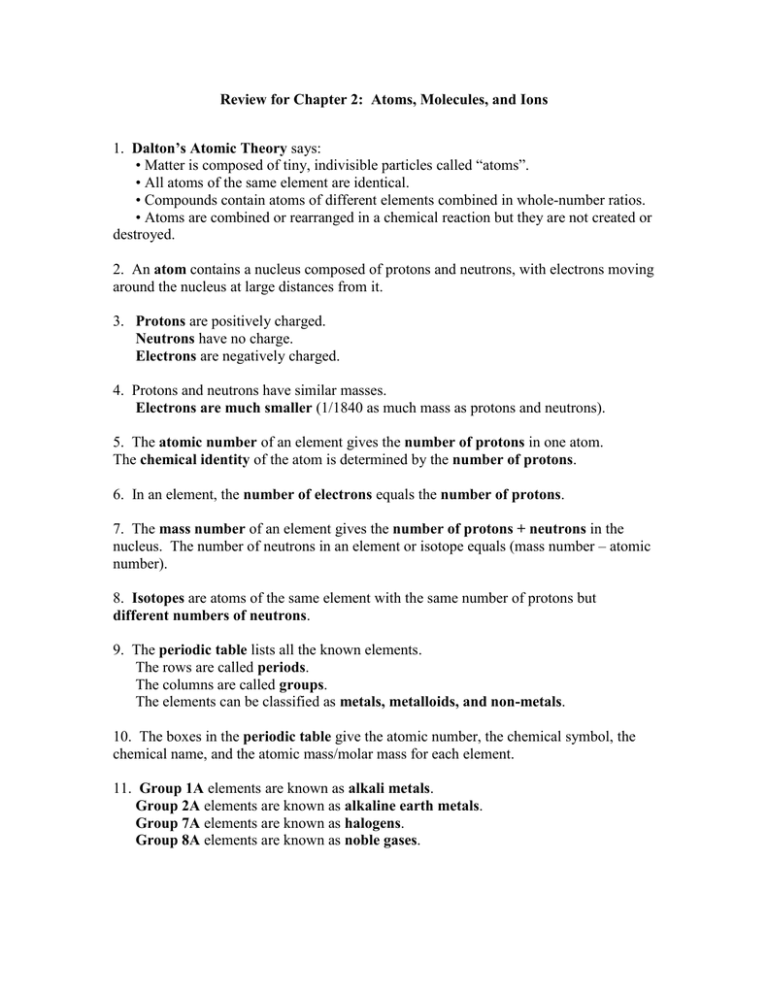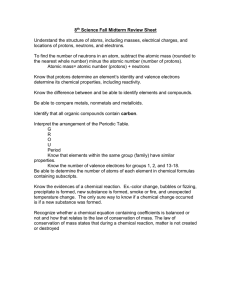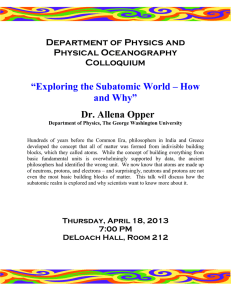Review for Chapter 2.doc
advertisement

Review for Chapter 2: Atoms, Molecules, and Ions 1. Dalton’s Atomic Theory says: • Matter is composed of tiny, indivisible particles called “atoms”. • All atoms of the same element are identical. • Compounds contain atoms of different elements combined in whole-number ratios. • Atoms are combined or rearranged in a chemical reaction but they are not created or destroyed. 2. An atom contains a nucleus composed of protons and neutrons, with electrons moving around the nucleus at large distances from it. 3. Protons are positively charged. Neutrons have no charge. Electrons are negatively charged. 4. Protons and neutrons have similar masses. Electrons are much smaller (1/1840 as much mass as protons and neutrons). 5. The atomic number of an element gives the number of protons in one atom. The chemical identity of the atom is determined by the number of protons. 6. In an element, the number of electrons equals the number of protons. 7. The mass number of an element gives the number of protons + neutrons in the nucleus. The number of neutrons in an element or isotope equals (mass number – atomic number). 8. Isotopes are atoms of the same element with the same number of protons but different numbers of neutrons. 9. The periodic table lists all the known elements. The rows are called periods. The columns are called groups. The elements can be classified as metals, metalloids, and non-metals. 10. The boxes in the periodic table give the atomic number, the chemical symbol, the chemical name, and the atomic mass/molar mass for each element. 11. Group 1A elements are known as alkali metals. Group 2A elements are known as alkaline earth metals. Group 7A elements are known as halogens. Group 8A elements are known as noble gases. 12. Chemical formulas are written with the chemical symbols and number subscripts showing the type and number of atoms contained in the smallest unit of the compound (for example, H2O, CO2, C2H4). 13. A molecular formula tells you the specific number and type of atoms in one molecule of a compound. An empirical formula tells you the simplest ratios of the atoms but not their exact numbers in the compound. 14. Chemical compounds are classified as either molecular compounds, in which the smallest units are distinct individual molecules, or ionic compounds, which are made of cations and anions arranged together. 15. Cations have a positive (+) charge (“cats are a plus”). Anions have a negative (-) charge (“a negative ion”). 16. Understand the process for naming ionic and molecular compounds (Figure 2.14). Table 2.3 lists the names of many common cations and anions and their charges. 17. Know the Greek prefixes used in naming compounds (Table 2.4). 18. Understand and be able to name acids and bases.




